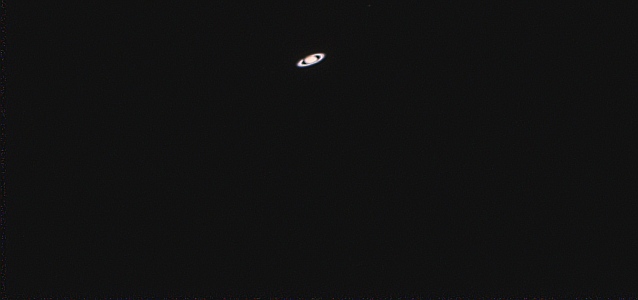Last updated: 10 June 2005
|
Last updated: 10 June 2005 |
This page documents the Meade Lunar Planetary Imager comments, tips, and photos. Contributions welcome. I have posted a review of using the Autostar Suite and LPI on the Macintosh. In order to showcase the LPI you may occasionally see images taken with other telescopes on this page.
Subject: Campo, resocion y tamao del chip de LPI de Meade Sent: Wednesday, June 8, 2005 04:20:56 From: Astroreus (astroreus@yahoo.es) Por fin he podido calcular el campo y la resolucin del LPI de Meade para mi telescopio ETX90. Estuve buscando por la red a ver si alguien saba el tamao del chip de la cmara y la verdad es que no hubo manera de encontrarlo, as que lo pongo aqu para quie lo quiera saber. Tamao de la imagen: Diagonal 6.5mm, 5,18mm x 3,90mm Pixels efectivos: 644(H) x 484(V) ~310K pixels Nmero total de pixels: 648(H) x 488(V) ~320K pixels Tamao del pixel: 8.0m(H) x 8.0m(V) Con estos datos me salen los siguientes resultados: Tamao del chip (Chip size): 3,9 mm x 5,2 mm Resolucin de la imagen con el etx 90: 1,32 seg/pixel Campo de la cmara: 10,60 min x 14,1 min (este es el valor que teneis que introducir en el "Cartes du ciel" para ver el campo de la camara con el telescopio) Todo esto est calculado con el CCD CALCULATOR de Ron Wodaski. Lo podeis descargar aqu. http://www.multimediamadness.net/newastro/downloads/ccdcalc/ccdcalcbasic.exeTranslation:
Finally I have been able to calculate the field and the resolution of the LPI of Meade for my telescope ETX90. I was looking for by the network to see if somebody knew the size of the chip of the camera and the truth is that there was no way to find it, so I put it here for quie wants it to know. Size of the image: Diagonal 6.5mm, 5,18mm effective xs 3,90mm Pixels: 644(H) x 484(V) ~310K pixels total Number of pixels: 648(H) So large x 488(V) ~320K pixels of the pixel: 8.0m(H) xs 8.0m(V) With these data leave the following results to me: Size of the chip (Chip size): 3.9 mm x 5.2 mm Resolution of the image with etx 90: 1,32 seg/pixel Field of the camera: 10,60 min x 14.1 min (this it is the value that teneis that to introduce in the "Cartes du ciel" to see the field of camara with the telescope) All this is calculated with CCD CALCULATOR of Rum Wodaski. Podeis to unload here. http://www.multimediamadness.net/newastro/downloads/ccdcalc/ccdcalcbasic.exe
Subject: Some Images from May 17, 2005 Sent: Wednesday, May 18, 2005 11:58:37 From: Phillips, Edward (Edward.B.Phillips@msfc.nasa.gov) Here are some images I took on May 17, 2005 using my Supercharged ETX-125 with LPI. The moon images shows some landing site of the Surveyor, Ranger, and Luna robitic probes. The Jupiter images show the moons Io and Ganymede using with and without X2 Barlow. Hope your web site read enjoy them. Edward B. Phillips NASA Marshall Space Flight Center Huntsville, AL E-mail: edward.phillips@msfc.nasa.gov

Subject: LPI Picture Sent: Sunday, May 8, 2005 22:47:27 From: User721401@aol.com (User721401@aol.com) Well I think I sort of got the hang of new 125 PE telescope...But for some reason this is what I get with the LPI...any suggestions??? By the way, that is Jupiter?!?!?!?!?!?!?!? I think it took about 80 pictures and this is what it came up with. ThanksMike here: Well, focus doesn't look too good. Either that or the seeing was lousy. Either will mess up the stacking. As to the color, odd.
Subject: Jupiter photo using ETX125+LPI Sent: Monday, May 2, 2005 13:19:27 From: John Blakely (blakelyj@sol.dnet.co.uk) Many thanks for a great web site. Here is my first astro-photo attempt using recently aquired ETX-125 UHC + LPI. I have not processed the image other than to let the LPI software stack 12 images. I set the scope up about 14m from my dining room window where my desktop PC lives. To achieve USB comms with the LPI over this distance I invested in a cheap USB mains powered hub and made up a couple of USB cables each 7m long. The hub sits halfway between the camera and the computer and acts like a USB extender which seems to work OK over this distance. Max recommended cable length for USB appears to be 5m so I pushed my luck a bit using 7m cables. The trickiest part of the process was achieving good LPI focus. I turned the PC monitor to the window and tried to tweak focus from the scope while peering at the monitor through a pair of binoculars. This proved useless! My son came to the rescue by standing at the window and relaying instructions. Maybe I need to invest in a laptop... Best Regards, John Blakely near Lisburn Northern Ireland
Subject: First pics Jupiter and Saturn From: jan.kolsto@online.no Date: May 1, 2005 04:43:13 PDT These were my first astropics. Any suggestions how to improve the pics?Mike here: Using the LPI (or any imager) takes practice and patience. It also takes good seeing and good focus. It also takes letting the telescope reach thermal equilibrium (at least 90 minutes for best results with an ETX-90). That said, those are pretty good images for first ones. The Saturn one looks like some motion occurred. Were these single frame shots or stacks of multiple images?Thanks for keeping up the brilliant page! Jan Norway

And:
They were "stacks" about 50 pics taken outside our house.There is sunshine rather late in Norway these days so I guess "the astronomy season "is fading out.Thanks a lot for responding.Thanks!
Return to the top of this page.
Go to the March-April 2005 LPI Page.
Go to the January-February 2005 LPI Page.
Go to the October-December 2004 LPI Page.
Go to the July-September 2004 LPI Page.
Go to the April-June 2004 LPI Page.
Go to the January-March 2004 LPI Page.
Go to the 2003 LPI Page.
Go back to the Astrophotography Page.
Go back to my ETX Home Page.